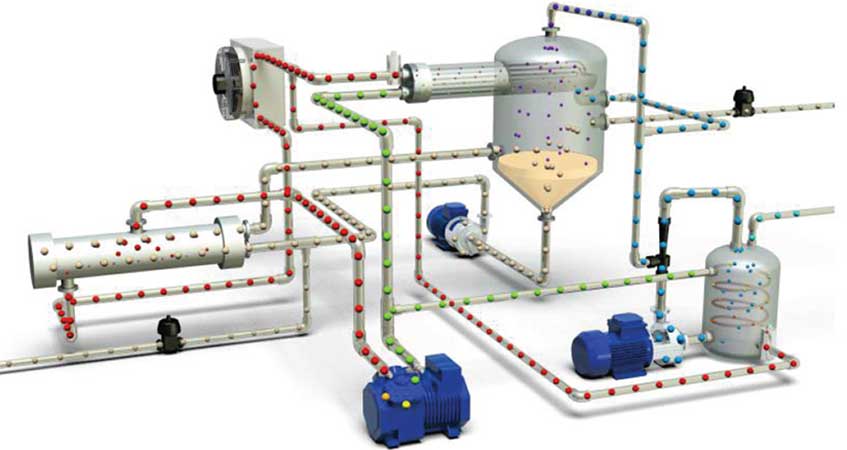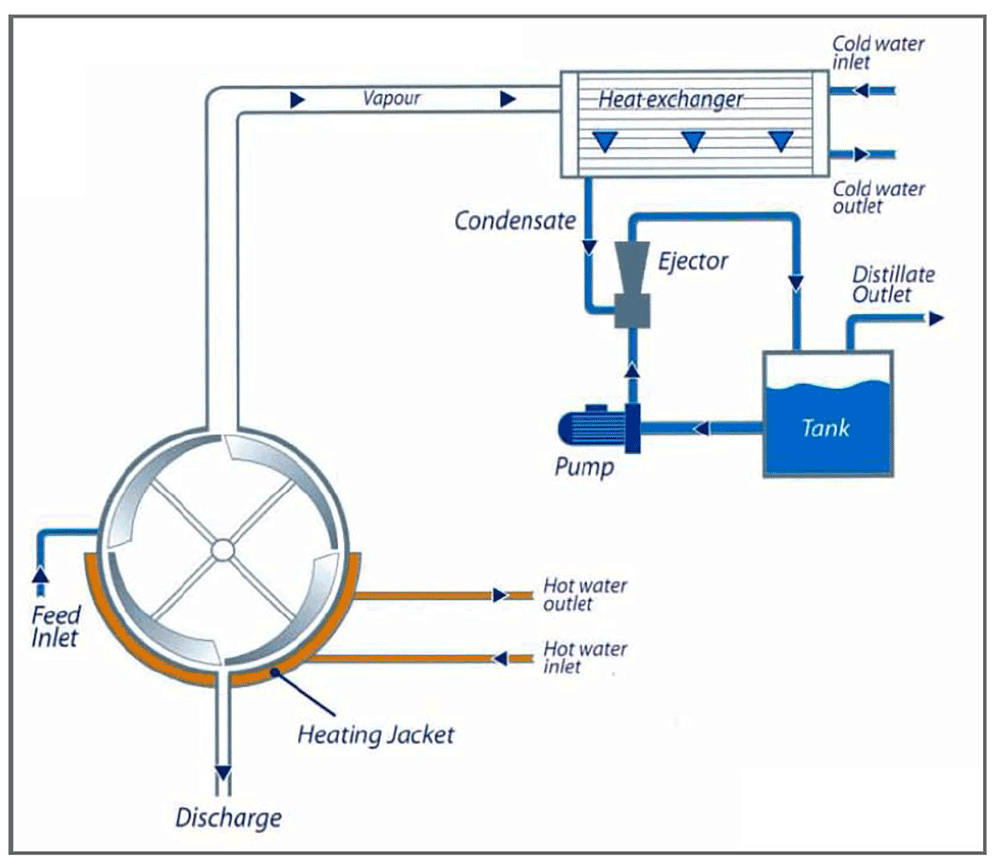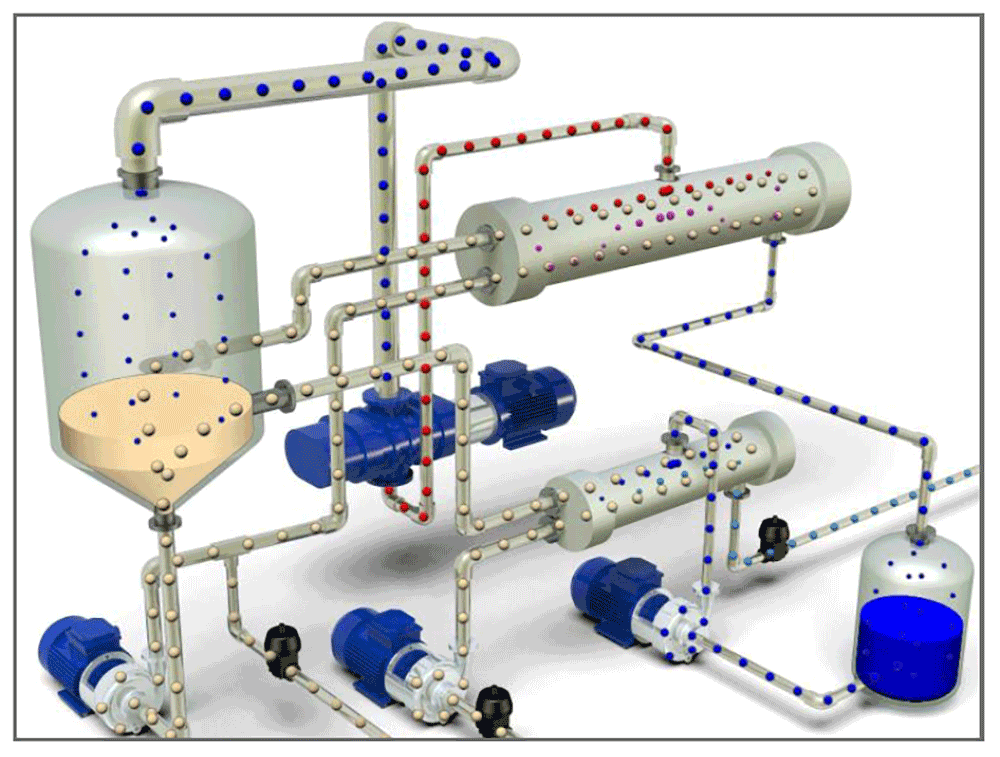
Evaporation, or distillation, is a separation process that takes advantage of the changing physical states of water, or other solvents, from liquid to vapor. It is unique from other separation processes, in that the water is removed from the contaminants rather than the pollutants being filtered from the water. Before recent technological developments, the capital and energy requirements for evaporation processes had been too intensive for wastewater treatment or recycling applications. The economical use of evaporation was limited to product recovery applications or when all other treatment methods had failed. For over 35 years, however, EVALED® evaporators and crystallizers throughout the world have been implemented as wastewater treatment and recycling solutions– economically and reliably. EVALED® heat pump vacuum evaporators, hot/cold water evaporators, and mechanical vapor recompression (MVR) systems offer clean, simple, and compact separation technology options for a wide range of difficult-to-treat industrial applications.
For concentrated waste such as produced water, which can contain 150,000 ppm TDS (total dissolved solids) or more, evaporation is the only practical and proven economical method for water recovery and reuse. Although other desalination technologies exist, such as reverse osmosis, the typical concentrations of bicarbonates, chlorides, sulfates, and hardness render processes that are common for pure water applications unreliable and maintenance cost-prohibitive for produced water treatment. Additionally, no other technology can attain as high-water recovery and concentration rates, capable of achieving residual total solids concentrations of over 85%, drastically reducing disposal costs.
Evaporator Technologies
Evaporators are categorized by heating source, circulation method, and heat exchanger devices. The heating source for evaporation can be supplied by hot water, steam, thermal fluids, flue gases, and electrical energy– either directly through resistance, or indirectly with a heat pump or mechanical vapor recompression. Circulation methods include natural circulation, forced recirculation, scraped, and thin film. Direct heat exchange techniques include immersion heaters, submerged combustion, or submerged steam. Indirect heat exchange techniques include internal or external shell & tube heat exchangers, plate heat exchangers, or heating jackets.
Atmospheric Evaporation
The most basic design of an evaporator is a kettle-type system. Direct heat is applied at atmospheric pressure to boil the water, typically using combustion or steam. This is the simplest, but most energy intensive evaporation method. Under normal atmospheric pressure conditions (101.3 kPa), increasing temperature of 1 kilogram of water from room temperature to boiling (100°C) and changing phase from liquid to vapor, the system requires the addition of approximately 2500 kilojoules (kJ) of energy, corresponding to ~0.7 kWh/L. This energy is lost to the atmosphere because latent heat from condensation is not recovered.
Multiple heating methods exist to recover the energy of condensation and water for reuse within the process cycle, reducing the total energy consumption for water evaporation by as much as 25 times, including heat pump vacuum evaporation, single or multiple effect distillation (MED), or mechanical vapor recompression (MVR) evaporator technologies.
Heat Pump Vacuum Evaporation
The heat pump vacuum evaporator offers reduced electrical energy consumption, and superior reliability for low to medium flow produced water treatment applications (40-12,680 gal/day). Evaporation occurs under high vacuum conditions, of 4 kPa absolute pressure, lowering the boiling point of water to a temperature of approximately 30 degrees Celsius.
Energy consumption is reduced to approximately 0.15 kWh/L of distillate (a 5x reduction compared to atmospheric evaporation) as most of the energy in the form of latent heat is reused for new vapor production. Electrical energy consumption primarily depends on the work required to compress the intermediate fluid, and to a small extent, fans to aid the air-cooling process. In addition to the reduced energy consumption, the high vacuum, low temperature conditions significantly reduce the foaming, scaling, and corrosion phenomena typical when highly concentrating produced water.
Hot/Cold Water – Single or Multiple Effect Distillation (MED)
MED exploits the same physical property of reduced temperature boiling under vacuum, while also utilizing the vapor produced within the first boiling stage (effect) to produce new vapor in a next stage at an even lower temperature and pressure. This vapor recycle can be cascaded several times in a (multiple effect) sequence. External heat energy is added only in the first chamber, typically provided by excess or waste hot water or steam. The vapor evaporated in the first stage continues to a condenser in the next effect where the latent heat is utilized to evaporate the liquid in the next stage. The latent heat of condensation remaining after the final stage is then absorbed by cooling tower water, an air-cooled exchanger, or a feed preheater, to condense the vapor for reuse.
The efficiency of the system is increased by each addition of an effect; however, this energy efficiency must be balanced with the increased capital cost of duplicating the core equipment. Energy consumption ranges from 0.018 kWh/L of distillate for a single-effect, to a low of 0.008 kWh/L for a typical four-effect evaporator. Capacities range from 790-15,800 gal/day of distillate production in package units, up to several MGD in large design-build systems.

Mechanical Vapor Recompression (MVR)
The low electrical energy consumption of MVR evaporators allow treatment on medium to high flow wastewater treatment applications (2,600-53,000 gal/day) where excess or waste hot water/steam and cooling water is not available.

The image at left shows the main components of a typical MVR evaporator. As opposed to a heat pump system, there is no intermediate thermal fluid needed in the MVR system. An electric resistance heater supplies the heat needed for initial evaporation. The vapor generated within the boiling chamber is then exploited for steady-state operation. A positive displacement compressor adiabatically compresses the vapor, increasing the pressure and temperature of the product vapor. The heated vapor transfers its latent energy in a primary heat exchanger, simultaneously providing the heat of evaporation for the waste liquid and condensation of the vapor to product distillate for reuse. A secondary heat exchanger recovers additional sensible heat from the distillate to preheat the incoming feed water, allowing a significant low energy consumption (approximately 0.03 kWh/L water, 25x lower than atmospheric evaporation).
Although the boiling temperature is somewhat higher than in a heat pump system (90°C), the high velocity of liquid flow in the heat exchangers due to forced circulation reduces scaling, deposits, and fouling on the heat exchange surfaces.
Choosing the Right Technology
A careful analysis of the chemical and physical properties of the waste fluid to be treated guides which type of evaporation should be applied. In addition to the utilities available and OPEX vs. CAPEX considerations for each evaporation technology, the equipment and devices specified for use in any evaporation system is application specific to the properties of the waste, fouling/scaling/corrosion potential, requirements for recycled water quality, and available destination options for the residual slurry.
To find out the best option for treating your industrial water or wastewater, contact us today.